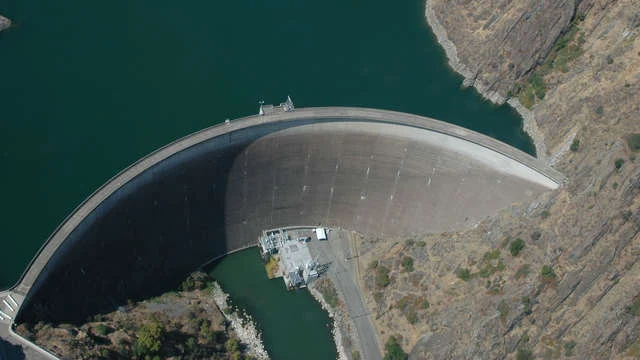Monticello Dam is a 304-foot (93 m) high concrete arch dam in Napa County, California, United States constructed between 1953 and 1957. The dam impounded Putah Creek to create Lake Berryessa in the Vaca Mountains.
Lake Berryessa is currently the seventh largest man-made lake in California. Water from the reservoir primarily supplies agriculture in the Sacramento Valley downstream. The dam is noted for its classic, uncontrolled morning-glory-type spillway.The diameter at the lip is 72 ft (22 m). Locally, the spillway is also known as the "Glory Hole
Though the dam and its 26-mile (42 km) long reservoir are located entirely in eastern Napa County, the dam lies less than 500 ft (150 m) west of the boundary with Yolo County. In addition, parts of the lake's watershed extend into Lake County. Monticello is a concrete medium thick arch dam 304 ft (93 m) high from the foundations, 1,023 ft (312 m) long and 239 ft (73 m) above the riverbed. The dam is 100 ft (30 m) thick at the base, tapering to 12 ft (3.7 m) at the crest. The total volume of construction materials is 326,000 cubic yards.
The capacity of the reservoir is 1,602,000 acre⋅ft , with a full surface area of 20,700 acres (8,400 ha). The maximum operating elevation is 440 ft (130 m); any higher water levels will flow over the dam's spillway. About 375,000 acre feet of runoff flow into the reservoir each year from its 566-square-mile watershed. The Monticello Dam Powerplant was completed in 1983 and has three generators, totaling a capacity of 11.5 megawatts (MW). The powerplant is operated and maintained by the Solano Irrigation District. The electrical power is sent mostly to the North Bay area of the San Francisco Bay Area.
As of 1992, about 71,445 acres, or nearly 75 percent, of the project command area was irrigated. Water is diverted 6 miles (9.7 km) downstream of Monticello at the Putah Diversion Dam, and distributed to farms through the 33-milePutah South Canal. The canal ends at Terminal Reservoir, which supplies water to the cities of Vallejo and Benicia. A 1999 contract provides for the delivery of 207,350 acre feet of water each year for irrigation. About 32,000 acre feet of municipal water are also supplied by the project.Since construction the dam and reservoir have prevented about $5,015,000 in flooding related damages
The dam's morning-glory-type spillway, known as the Glory Hole, is 72 feet (22 m) in diameter at lake level and narrows down to about 28 feet (8.5 m) at the exit. At the lake's peak level, the spillway can drain 48,400 cubic feet per second, which occurs when the lake level rises to 15.5 feet (4.7 m) above the level of the funnel. Water spills over its lip when the lake reaches 1,602,000 acre feet and a reservoir elevation of 440 feet (130 m) above sea level. The last time the reservoir naturally spilled through the glory hole was on the afternoon of February 26, 2019.
Prior to that, the last time the spillway was active was February 16, 2017. After a number of storms had caused the lake level to rise 35.5 inches since January 1, 2017, the reservoir was on the cusp of spilling once again at 439.2 feet. Eager to witness this event, a number of local boaters and recreation enthusiasts generated enough wake to cause the reservoir to spill, albeit briefly, at 1:45 p.m. on February 13, 2017. Lake Berryessa reservoir filled and ran into its glory hole spillway for the first time in over a decade on February 16, 2017.






No comments:
Post a Comment
Stay updated with our blog for more quality content! Your feedback is appreciated. Contact us at harshrex@outlook.com with any suggestions.